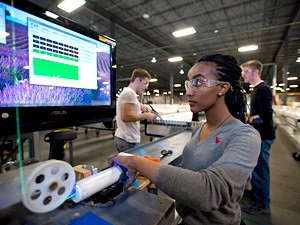A NOvA experience for students

Students build detectors for a classic physics experiment
When Luke Wolf decided to study history, he never dreamed he would soon be making it himself.
But as one of the 250 University of Minnesota students building the elements of a major international physics experiment, that's exactly what he's doing.
Called NOvA, the $283 million experiment will study neutrinos, ultra-tiny particles that date from the Big Bang and may be the key reason our universe didn't promptly annihilate itself. Starting later this year, neutrinos will be generated and shot through the earth from the Department of Energy's Fermilab in Illinois to remote Ash River, Minnesota; there, a gigantic neutrino detector, built from components the students are now making, is being installed to capture some of the particles.
NOvA depends on the students to thread sensitive fiber optic cable through long (over 50 feet), thin "modules," or tubes, of sturdy PVC, testing the fiber as they go. They also seal the finished modules, check for leaks, and send them to Ash River, where all 12,000-plus modules will be filled with oil and assembled into a detector 256 feet long, 50 feet wide, and 50 feet tall.
As neutrinos arrive from Fermilab, almost all will zip right through the detector. But a very few will interact with atomic nuclei in the oil, leaving a "signature" of light to be picked up by the fiber optic cables.
"Just being part of something this big, and having this experience, is exciting," says Wolf, who also helped build carts and tools for the project. "Colleges around the country and in Europe are part of this."
The undergrads, along with graduate students, faculty, and postdocs, built everything from carts and tables to machines that cut, shape, and align parts with accuracies of up to a thousandth of an inch. And with that accomplishment comes a heavy responsibility.
"Last summer, [machines that tested and cut fiber optic cables] were going haywire," Wolf says. "But there was nobody to call up for help. We had to fix them ourselves."
Their workshop is a warehouse, dubbed the Module Lab, a stone's throw from campus.
Partial to particles
Working on the NOvA project is just the ticket for physics major Jacki Hoseth, who envisions a career as a particle physicist.
"It's fascinating to find tiny particles that make up everything," she says. "I'm partial to neutrinos. It's weird that they can go through so much matter without hitting anything."
Moving up
The Module Lab employs seven full-time staff (mostly former students) from the School of Physics and Astronomy and allows undergrads to rise to the position of student manager—Wolf is one—and as high as honorary full-timer, meaning they can do the job of a full-time staffer.
Hoseth works in quality assurance, testing the light fibers and checking the modules to make sure they conduct light properly and have no leaks. After testing, the quality assurance team stacks and ships the modules.
"The most fun part of the job is the people here. They're really friendly," she notes. "It's a good job experience because you learn how to deal with people and manage."
"This job gives the students a chance to discover how talented they are and develop confidence in their abilities," says Nathaniel Pearson, manager at the Module Lab. "They're hungry for the chance to prove themselves, and when you give them the opportunity to do something on their own, they go for it."
Not your average workplace
Chemistry major Anna Turgeon's job involves sealing both ends of modules with clamps and three kinds of glue.
"I worked in a coffee shop—this is quite different," says Turgeon, whose interests run to cosmetic chemistry and a career formulating better sunscreens. "I wanted to work in an environment where I could live and breathe science and to be around people who've had similar experiences and classes.
"Being around this project makes me more interested in physics. And it's unbelievable to me to be part of something that so many people are part of and that's known nationally."
After several years working closely with the students, Pearson has nothing but praise for them.
"They're the best and the brightest, and the results they produce are inspiring," he says. "It's a pleasure for me to have them in the lab making these modules."
